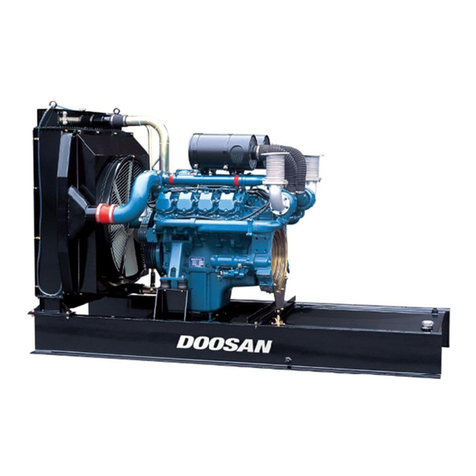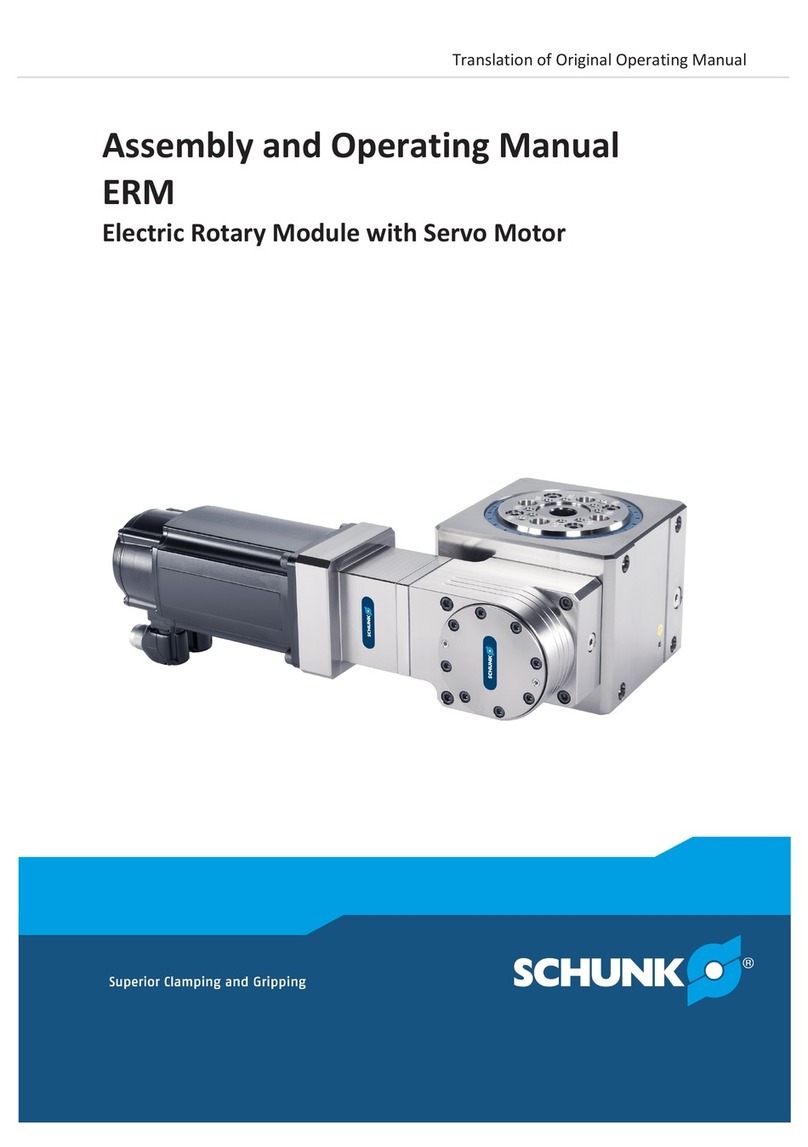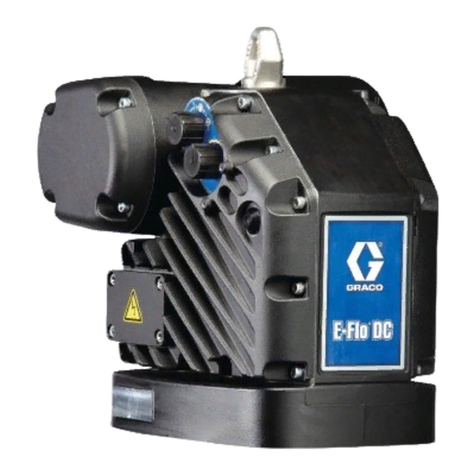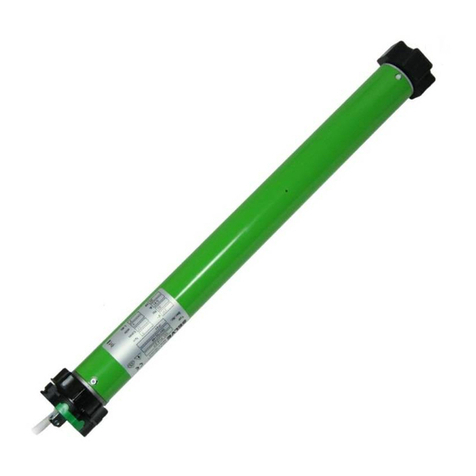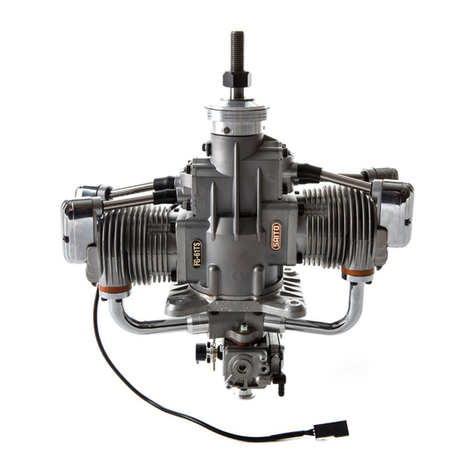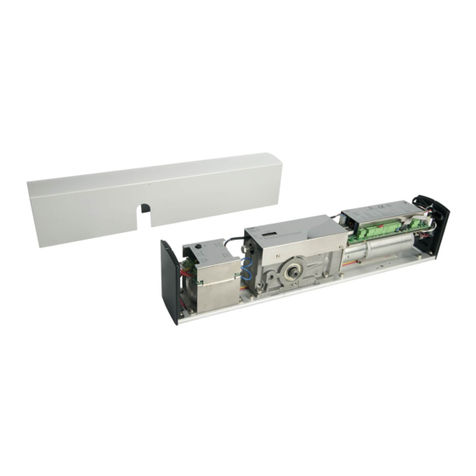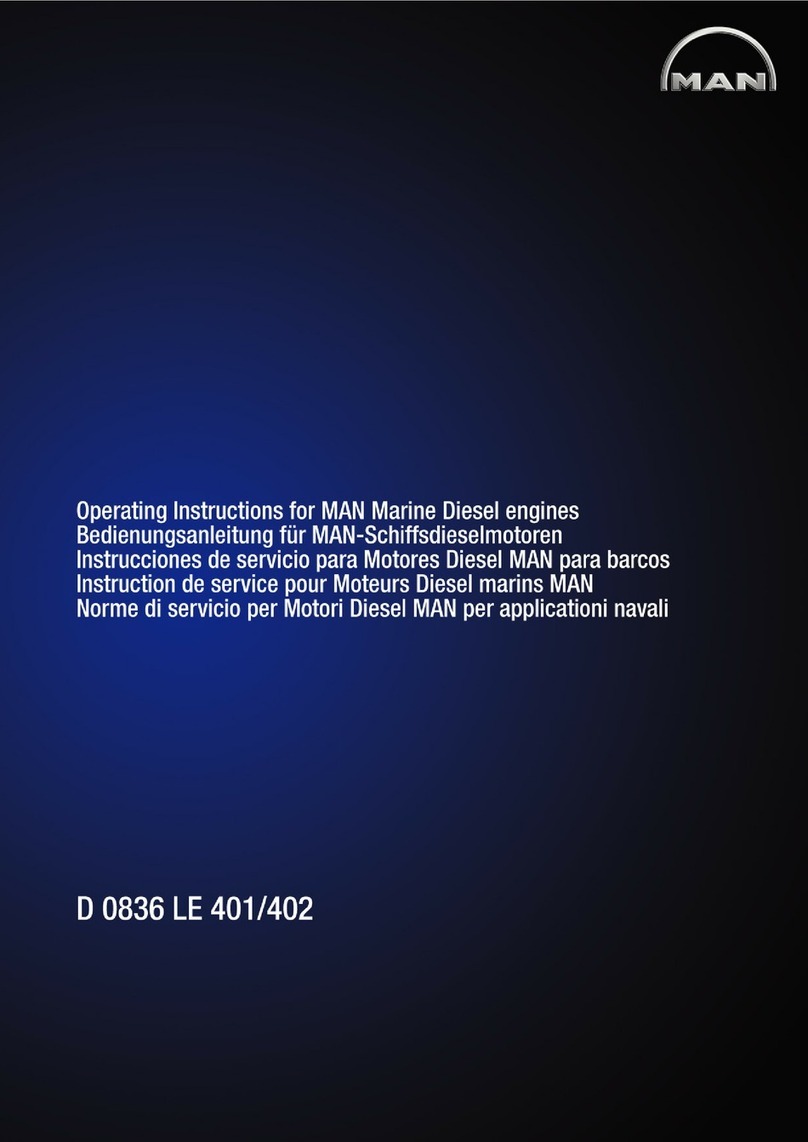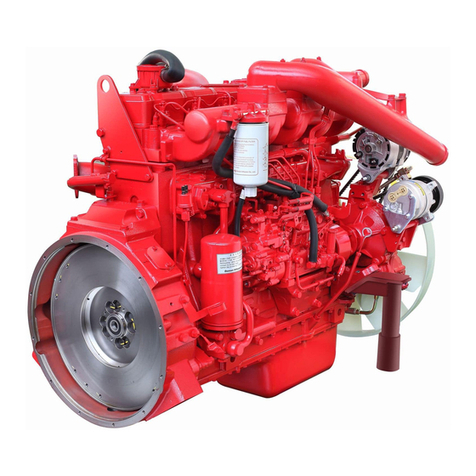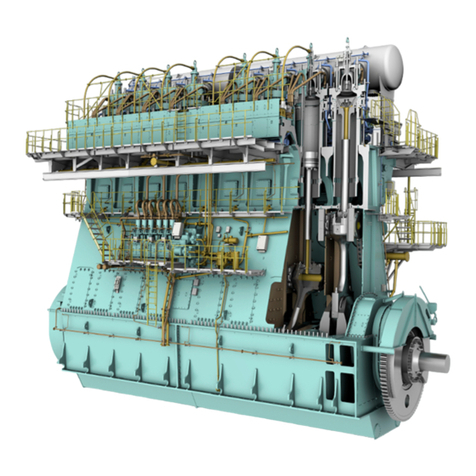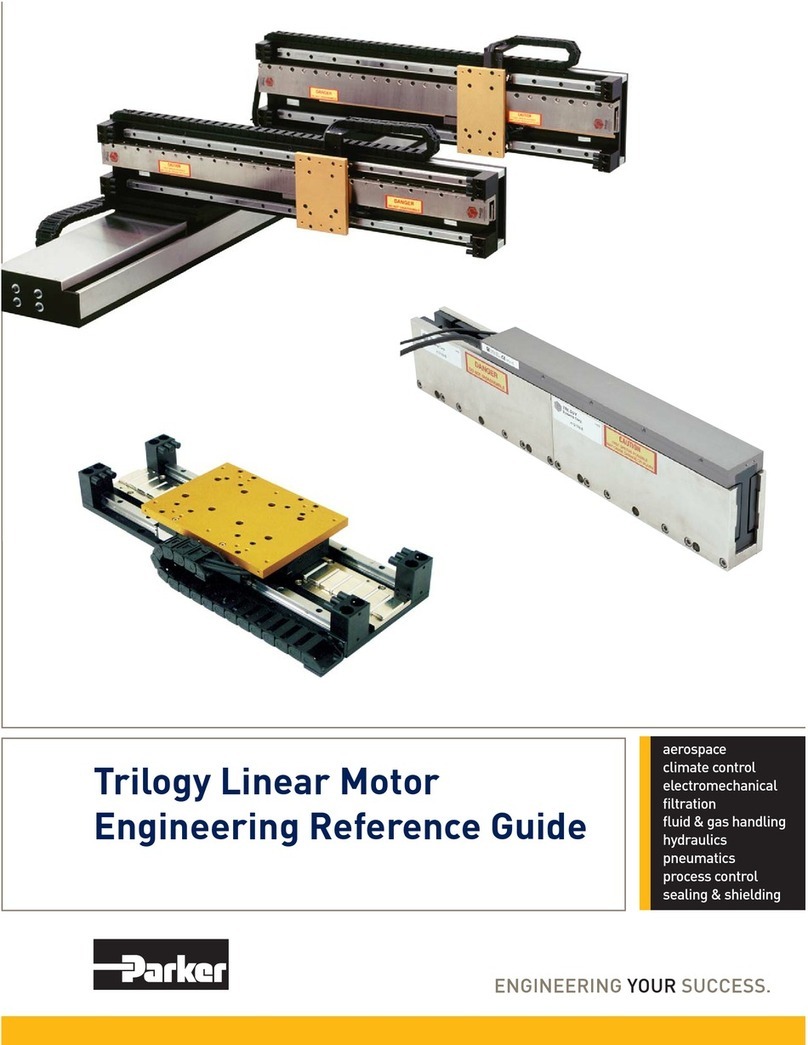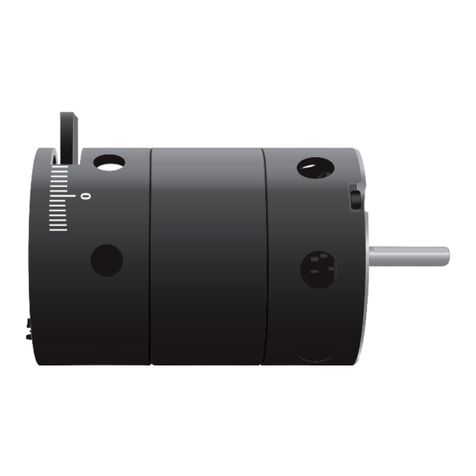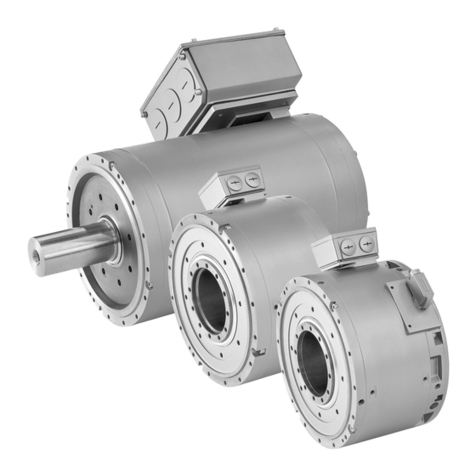Daewoo POLUS P126TI User manual

65.99892-8051
Operation Manual
GENERATOR DIESEL ENGINE
DE12T
POLUS
P126TI

FOREWORD
This manual has been prepared to help you use and maintain the DE12T/ P126TI generator diesel
engines in a safe and correct manner.
These economical and high-performance diesel engines (OMEGA combustion system) have been
designed and manufactured for generator application. They meet all the requirements such as low
noise, fuel economy, high engine speed, and durability.
Nonetheless, to obtain the best performance and long life of an engine, it is essential to operate it
appropriately and to carry out periodic checks as instructed in this manual. We strongly urge you to
thoroughly read this manual from cover to cover and to acquaint yourself fully with all the information
contained in this manual.
Please contact your authorized DAEWOO dealer for the answers to any questions you may have
about your DE12T/ P126TI generator engine’s features, operation, or manuals.
In order to operate the engine in the optimal conditions and to maintain its best performances, the
contents in this instruction are to be thoroughly understood and observed.
In addition refer to the INSTALLATION manual about DAEWOO generator engine installation instruc-
tions.
All warranty claims to be addressed to;
Engine Export Team,
DAEWOO Heavy Industries LTD.
DAEWOO Center 541
Namdaemun-ro 5-ga, Chung-gu
Seoul, Korea
TEL : (82-2-726-3205~8), FAX: (82-2-726-3168)
Or to your local DEALER or DISTRIBUTOR.
DAEWOO Heavy Industries LTD.
July. 1999

CONTENTS
1. General information................................................................................................................... 1
1.1. Engine specification 1.2. Engine assembly
2. Safety regulations...................................................................................................................... 6
2.1. General notes 2.4. Regulations designed to prevent pollution
2.2. Regulations designed to prevent accidents 2.5.
Notes on safety in handling used engine oil
2.3. Regulations designed to prevent damage
3. Technical information.............................................................................................................. 10
3.1. Engine model and serial number 3.7. Intercooler
3.2. Engine type 3.8. Fuel system
3.3. Engine timing 3.9. Cooling system
3.4. Valves 3.10. V-belt tension check and adjust
3.5. Lubrication system 3.11. Turbocharger
3.6. Air cleaner 3.12. Electrical equipment
4. Commissioning and operation............................................................................................... 26
4.1. Preparation 4.4. Operation in winter
4.2. Breaking-in 4.5. Tuning the engine
4.3. Inspection after starting
5. Inspection and maintenance .................................................................................................. 30
5.1. Periodical inspection and maintenance 5.5. Fuel system
5.2. Lubrication system 5.6. Injection nozzle maintenance
5.3. Cooling system 5.7. Turbocharger
5.4. Air intake system
6. Checking and setting .............................................................................................................. 42
6.1. Adjustment of valve clearance 6.4. Cylinder compression pressure
6.2. Adjustment of injection timing 6.5. V-belts
6.3. Tightening the cylinder head bolts
• Appendix....................................................................................................................................
49
• WORLDWIDE NETWORK

Engine Model
Items DE12T P126TI P126TI-I
Engine type
Water-cooled, 4 cycle in-line
Water-cooled, 4 cycle in-line
type
type Turbo charged
Turbo charged & intercooled
Combustion chamber type Direct injection type
Cylinder liner type Replaceable dry liner
Timing gear system Gear driven type
No. of piston ring Compression ring 2, oil ring 1
No. of cylinder-bore
x
stroke (mm) 4 - 123
x
155
Total piston displacement (cc) 11,051
Compression ratio 17.1 : 1
Engine dimension (length
x
width
x
height) (mm) 1,365.5
x
870
x
1,046
1,383
x
870
x
1,207
Engine weight (kg) 910
Rotating direction (from flywheel) Counter clockwise
Fuel injection order 1 - 5 - 3 - 6 - 2 - 4
Fuel injection timing (B.T.D.C static) 12
°
Injection pump type Zexel in-line “P” type
Governor type
Mechanical governor type(RSV)
Electric governor type(GAC)
Injection nozzle type
Multi-hole type (5 hole)
Multi-hole type (5 hole)
Fuel injection pressure (kg/cm2) 220 1st : 160, 2nd : 220
Compression pressure (kg/cm2) 28 (at 200 rpm)
Condition 50Hz 60Hz 50Hz 60Hz 60Hz
(1,500rpm) (1,800rpm) (1,500rpm) (1,800rpm) (1,800rpm)
Continuous --
280PS 336PS -
Power (ISO 3046) (206kW) (247kW)
Prime 205PS 245PS 328PS 378PS 356PS
(151kW) (180kW) (241kW) (278kW) (262kW)
Stand by 226PS 270PS 370PS 405PS 392PS
(166kW) (199kW) (272kW) (298kW) (288kW)
I
ntake and exhaust valve clearance (at cold) (mm)
0.3
Intake valve Open at 18
°
(B.T.D.C)
Close at 34
°
(A.B.D.C)
Exhaust valve Open at 46
°
(B.B.D.C)
Close at 14
°
(A.T.D.C)
Lubrication method Full forced pressure feed type
Oil pump type Gear type driven by crankshaft
Oil filter type Full-flow, Cartridge type
Lubricating oil capacity (max./min.) (lit) 23/20
Oil cooler type Water cooled
Water pump Gear driven impeller type
Cooling Method Pressurized circulation
Cooling water capacity (engine only) (lit) 19
Thermostat type Wax pallet type (83 ~ 95
°
C)
Alternator voltage - capacity (V - A) 24 - 45
Starting Motor voltage - output (V - kW) 24 - 6.0
1. General information
1.1. Engine specification
- 1 -

1.2. Engine assembly
1.2.1. Engine sectional view (Longitudinal)
- 2 -
EA8M1002
1
2
10 11 12 13 14 15 16 17 18
3 4 56789
1. Cooling fan
2. Exhaust valve
3. Valve spring
4. Oil filter
5. Tappet
6. Push rod
7. Piston pin
8. Piston
9. Combustion chamber
10. Crankshaft pulley
11. Vibration damper
12. Oil pump
13. Crankshaft
14. Oil pan
15. Connecting rod
16. Camshaft
17. Flywheel housing
18. Flywheel

1.2.2. Engine sectional view (Cross)
- 3 -
EA8M1003
1
2
10
11
12
3
4
5
6
789
1. Intake manifold
2. Fuel filter
3. Oil cooler
4. Injection pump
5. Cylinder block
6. Oil filter
7. Injection nozzle assembly
8. Rocker arm
9. Cylinder head cover
10. Exhaust manifold
11. Piston ring
12. Turbocharger

- 4 -
EA8M1004
1 2 3 12 4 27 13 18
5
22
23
16
14 20 21 26
25
24
17 15 197 11 10869
1. Cooling fan
2. Cooling water pipe
3. Oil filler cap
4. Cylinder head cover
5. Turbocharger
6. Oil drain valve
7. Alternator
8. Oil pan
9. Starter
10. Flywheel housing
11. Flywheel
12. Exhaust manifold
13. Injection nozzle assembly
14. Oil filter
15. Fuel filter
16. Oil cooler
17. Intake manifold
18. Injection pipe
19. Thermostat
20. Injection pump
21. Oil level gauge
22. Mounting bracket
23. Vibration damper
24. Water pump
25. Fan drive
26. Crankshaft pulley
27. Breather
1.2.3. Engine assembly views
1) DE12T

2)
P126TI
- 5 -
EA8M1005
12
768910
14 15 16 17 18 19
20 21
22
23
24
25
11
345 12 13
1. Cooling fan
2. Cooling water pipe
3. Air pipe
(Intercooler Intake manifold)
4. Air pipe
(Air cleaner Turbocharger)
5. Turbocharger
6. Oil drain valve
7. Air pipe
(Intercooler Intake manifold)
8. Oil pan
9. Starter
10. Flywheel housing
11. Flywheel
12. Exhaust manifold
13. Injection nozzle assembly
14. Oil filter
15. Breather hose
16. Oil cooler
17. Intake manifold
18. Injection pipe
19. Thermostat
20. Injection pump
21. Oil level gauge
22. Mounting bracket
23. Vibration damper
24. Water pump
25. Fan drive

2. Safety regulations
2.1. General notes
Day-to-day use of power engines and the service products necessary for running them
presents no problems if the persons occupied with their operation, maintenance and care are
given suitable training and think as they work.
This summary is a compilation of the most important regulations. These are broken down into
main sections which contain the information necessary for preventing injury to persons,
damage to property and pollution. In addition to these regulations those dictated by the type of
engine and its site are to be observed also.
Important :
If, despite all precautions, an accident occurs, in particular through contact with caustic
acids, fuel penetrating the skin, scalding from oil, antifreeze being splashed in the eyes
etc., consult a doctor immediately.
2.2. Regulations designed to prevent accidents
2.2.1. During commissioning, starting and operation
Before putting the engine into operation for the first time, read the operating instructions
carefully and familiarize yourself with the “critical” points, If you are unsure, ask your
DAEWOO representative.
•
For reasons of safety we recommend you attach a notice to the door of the engine room
prohibiting the access of unauthorized persons and that you draw the attention of the
operating personal to the fact that they are responsible for the safety of persons who enter
the engine room.
•
The engine must be started and operated only by authorized personnel. Ensure that the
engine cannot be started by unauthorized persons.
•
When the engine is running, do not get too close to the rotating parts. Wear close-fitting
clothing.
•
Do not touch the engine with bare hands when it is warm from operation risk of burns.
•
Exhaust gases are toxic. Comply with the installation instructions for the installation of
DAEWOO generator diesel engines which are to be operated in enclosed spaces. Ensure
that there is adequate ventilation and air extraction.
•
Keep vicinity of engine, ladders and stairways free of oil and grease.
Accidents caused by slipping can have serious consequences.
- 6 -

2.2.2. During maintenance and care
•
Always carry out maintenance work when the engine is switched off. If the engine has to be
maintained while it is running, e.g. changing the elements of change-over filters, remember
that there is a risk of scalding. Do not get too close to rotating parts.
•
Change the oil when the engine is warm from operation.
Caution :
There is a risk of burns and scalding. Do not touch oil drain valve or oil filters with bare
hands.
•
Take into account the amount of oil in the sump. Use a vessel of sufficient size to ensure that
the oil will not overflow.
•
Open the coolant circuit only when the engine has cooled down. If opening while the engine
is still warm is unavoidable, comply with the instructions In the chapter entitled “Cooling”.
•
Neither tighten up nor open pipes and hoses (lube oil circuit, coolant circuit and any additional
hydraulic oil circuit) during the operation. The fluid which flow out can cause injury.
•
Fuel is inflammable. Do not smoke or use naked lights in its vicinity. The tank must be filled
only when the engine is switched off.
•
Keep service products (anti-freeze) only in containers which can not be confused with drinks
containers.
•
Comply with the manufacturer’s instructions when handling batteries.
Caution :
Accumulator acid is toxic and caustic. Battery gases are explosive.
2.2.3. When carrying out checking, setting and repair work
•
Checking, setting and repair work must be carried out by authorized personnel only.
•
Use only tools which are in satisfactory condition. Slip caused by the worn open-end wrench
could lead to Injury.
•
When the engine is hanging on a crane, no-one must be allowed to stand or pass under it.
Keep lifting gear in good condition.
•
When checking injectors, do not put your hands under the jet of fuel.
Do not inhale at atomized fuel.
•
When working on the electrical system disconnect the battery earth cable first. Connect it up
again last in prevent short circuits.
2.3. Regulations designed to prevent damage to engine and premature wear
1) Never demand more of the engine than it was designed to yield for its intended purpose.
Detailed information on this can be found in the sales literature. The injection pump must not
be adjusted without prior written permission of DAEWOO.
- 7 -

2) If faults occur, find the cause immediately and have it eliminate in order to prevent more
serious of damage.
3) Use only genuine DAEWOO spare parts. DAEWOO will accept no responsibility for damage
resulting from the installation of other parts which are supposedly “just as good”.
4) In addition to the above, note the following points.
•
Never let the engine run when dry, i.e. without lube oil or coolant. Use only DAEWOO-
approved service products (engine oil, anti-freeze and anticorrosion agent).
•
Pay attention to cleanliness, The Diesel fuel must be free of water. See “Maintenance and
care”.
•
Have the engine maintained at the specified intervals.
•
Do not switch off the engine immediately when it is warm, but let it run without load for about
5 minutes so that temperature equalization can take place.
•
Never put cold coolant into an overheated engine. See “Maintenance and care”.
•
Do not add so much engine oil that the oil level rises above the max. marking on the dipstick.
Do not exceed the maximum permissible tilt of the engine. Serious damage to the engine may
result if these instructions are not adhered to.
•
Always ensure that the testing and monitoring equipment (for battery charge, oil pressure, and
coolant temperature) function satisfactorily.
•
Comply with instructions for operation of the alternator. See “Commissioning and operation”.
•
Do not let the water pump run dry. If there is a risk of frost, drain the water when the engine
switched off.
2.4. Regulations designed to prevent pollution
2.4.1. Engine oil, filter element, fuel filter
•
Take old oil only to an oil collection point. Take strict precautions to ensure that oil does not
get into the drains or into the ground.
•
The drinking water supply may be contaminated.
•
Oil and fuel filter elements are classed as dangerous waste and must be treated as such.
2.4.2. Coolant
•
Treat undiluted anti-corrosion agent and / or antifreeze as dangerous waste.
•
When disposing of spent coolant comply with the regulations of the relevant local authorities.
2.5. Notes on safety in handling used engine oil
Prolonged or repeated contact between the skin and any kind of engine oil decreases the skin.
Drying, irritation or inflammation of the skin may therefore occur. Used engine oil also contains
dangerous substances which have caused skin cancer in animal experiments. If the basic
rules of hygiene and health and safety at work are observed, health risks are not to the
expected as a result of handling used engine oil.
- 8 -

Health precautions
•
Avoid prolonged or repeated skin contact with used engine oil.
•
Protect your skin by means of suitable agents (creams etc.) or wear protective gloves.
•
Clean skin which has been in contact with engine oil.
- Wash thoroughly with soap and water, A nailbrush is an effective aid.
- Certain products make it easier to clean your hands.
- Do not use petrol, Diesel fuel, gas oil, thinners or solvents as washing agents.
•
After washing apply a fatty skin cream to the skin.
•
Change oil-soaked clothing and shoes.
•
Do not put oily rags into your pockets.
Ensure that used engine oil is disposed of properly.
- Engine oil can endanger the water supply -
For this reason do not let engine oil get into the ground, waterways, the drains or the sewers.
Violations are punishable. Collect and dispose of used engine oil carefully.
For information on collection points please contact the seller, the supplier or the local
authorities.
- 9 -

3. Technical information
3.1. Engine model and serial number
The engine model and serial number is
located on the engine as illustrated. These
numbers are required when requesting
warranty and ordering parts. They are also
referred to as engine model and serial
number because of their location.
•
Engine serial No. (example 1 : DE12T)
EBHGA900001
Serial No.
Production Year(19x9)
Engine Model Suffix
•
Engine serial No. (example 2 : P126TI)
EDIGA900001
Serial No.
Production Year(1999)
Engine Model Suffix
- 10 -
Engine Number
EA8O3001
EA9O2002
DAEWOO HEAVY INDUSTRIES LTD.
MODEL
SPEED 1500/1800 rpm
STAND-BY
PRIME
BORE mm
mm
cc
STROKE
VOLUME
YEAR
SERIAL NUMBER
EA9O2003
IMPORTANT ENGINE INFORMATION
DAEWOO HEAVY INDUSTRIES LTD.
ENGINE AND MATERIAL DIV.
6, MANSECOK-DONG, DONG-GU
INCHEON, KOREA
TYPE 2-D DIESEL FUEL.
THIS DAEWOO HEAVY-DUTY DIESEL MODEL
EPA AND CARB STANDARDIZED ENGINE FAMILY DESIGNATION IS
TUNE-UP SPECIFICATIONS AND ADJUSTMENTS
IS CERTIFIEDTO OPERATE ON
< Name Plate : General >
< Name Plate : EPA & CARB >

3.2. Engine type
The Engines DE12T/ P126TI are in-line vertical water-cooled 6-cylinder four-stroke diesel
engines with direct injection. DE12T is turbo-charged engine, and P126TI model is turbo-
charged and inter-cooled engine.
3.2.1. Cylinder block
The cylinder block is a single piece of alloy cast iron. To increase its stiffness, it is extended
to a level below the crankshaft center line. The engine has replaceable dry cylinder liners
and individual cylinder heads with struck-in valve seat rings and replaceable valve guides,
3.2.2. Piston con-rod / crankshaft
The forged crankshaft is a ingrate type (Counterweight is integrated with crank shaft body).
Radial oil seal on crankshaft and flywheel are provided to seal the flywheel housing inside
penetrations.
The con-rods (connecting rods) are die-forged, diagonally split and can be removed through
the top of the cylinders together with the pistons. Crankshaft and connecting rods run in
steel-backed lead bronze ready-to fit type bearings.
- 11 -

3.3. Engine timing
Camshaft, oil pump and injection pump are driven by a gear train arranged at the front end.
3.4. Valves
The overhead valves are actuated via chilled cast iron tappets, push rods and rocker arms
from the camshaft.
- 12 -
EA8O3002
Injection pump gear
(Z = 72) Water pump gear
(Z = 29)
Camshaft gear
(Z = 72)
Crankshaft gear
(Z = 36)
Oil pump idle gear
(Z = 31)
Oil pump drive gear
(Z = 32)
Idle gear
(Z = 52)

3.5. Lubrication system
The engine is equipped with force-feed lubrication.
The pressure is produced by a gear pump whose drive gear is in direct mesh with the
crankshaft gear at the front end of cylinder block.
The oil pump draws the oil from the oil sump and delivers it through the oil cooler and oil filter
to the main distributor gallery and from there to the main bearings, big-end bearings and
camshaft bearings as well as to the small-end bearings and the rocker arms.
The injection pump and the turbocharger are also connected to the engine lubricating system.
The cylinder walls and timing gears are splash-lubricated.
Each cylinder has an oil jet provided for cooling the underside of the pistons.
The lube oil is cleaned in a full-flow oil filter.
3.5.1. Recommend of lubricating oil
Initial factory fill is high quality break-in oil for API Service CD. During the break-in period (50
hours), frequently check the oil level. Somewhat higher oil consumption is normal until piston rings
are seated. The oil level should be maintained in the safe range between the Min. and Max.
marks on the dipstick. The safe range between the marks represents approximately 3 liters. To
obtain the best engine performance and engine life, grade of engine oil is recommended. Engine
oils are specified by API Service, letter designations and SAE viscosity numbers. If the
specified motor oil is not available, use a reputable brand of engine oil labeled for API Service
CD and SAE viscosity 30 or 15w40. Refer to oil identification symbol on the container.
Engine oil should be changed at the specified intervals. (800hr)
- 13 -
EA8O3003
RELIEF VALVE CYLINDER BLOCK MAIN GALLERY
IDLE GEAR SHAFT
IDLE GEAR FACE
CRANK PIN
SPRAY NOZZLE INJECTION PUMPCRANK JOURNAL
ROCKER ARM SHAFT
CAM SHAFT BEARING
OIL FILTER
OIL COOLER
OIL PUMP
OIL STRAINER
OPENING PRESSURE
4.0 ~ 5.0 kg/cm2
BY - PASSVALVE
1.8 ~ 2.3 kg/cm2
OIL SPRAY VALVE
1.5 ~ 1.8 kg/cm2
BY - PASSVALVE
5.0 ~ 6.0 kg/cm2
RELIEF VALVE
10 +1.5 kg/cm2
VALVE ROCKER ARM
VALVETAPPET
TURBO CHARGER

3.5.2. Oil cooler
An oil cooler is provided between the oil filter and the cylinder block. This cooler is a flat tube
type with turbulence inserts and operated by the coolant.
3.5.3. Oil filter
Check for oil pressure and oil leaks, and
repair or replace the oil filter if necessary.
Change the oil filter cartridge simultaneously
at every replacement of engine oil.
- 14 -
SAE 20, 20W
SAE 10W SAE 30
SAE 40, 50
SAE 10W - 30
SAE 5W - 20
SAE 15W - 40
SAE 10W - 40, 20W - 40, 20W - 50
-30 C
Single
grade
Ambient
temp
Multi
grade
(-20 F) -15 C
(-0 F) -0 C
(-32 F) 15 C
(60 F) 25 C
(80 F) 30 C
(90 F)
EA4M1008
Engine oil viscosity - ambient temperature
Oil filter (Cartridge)
Oil filter head
EQM4010I

3.6. Air cleaner
In case that elements are deformed, damaged
or if the air cleaner has a crack, replace it.
By the definite interval, the elements must be
cleaned and replaced.
- Cleaning of air cleaner element: Every 200
hours.
- Changing of air cleaner element: Every 600
hours.
3.7. Intercooler
The intercooler is air to air type and has a large cooling fan capacity. The intercooler life and
performance depends on the intake air condition greatly. Fouled air pollutes and clogs the air
fins of intercooler. As a result of this, the engine output is decreased and engine malfunction is
occurred. So you always check whether the intake air systems like air filter element are worn
or polluted.
- Cleaning of intercooler fins: Every 600 hours.
- 15 -
EFM1002I
EA5O4003
Air/air intercooler
with downstream
radiator
(Combined radiator)
Cooling air
Hot charge air
from compressor
Recooled charge air
to intake pipe (max. 50 C)

3.8. Fuel system
The fuel is delivered by the fuel feed pump via the fuel filter to the injection pump and from
there to the injection nozzles.
The fuel is sprayed into the cylinders through nozzles fitted in screw-fit injection nozzle holders
in the cylinder heads.
Excessively delivered fuel and leak fuel from the nozzle flow through the return pipe back to
the tank.
A strainer is arranged ahead of the fuel feed pump.
1. Fuel filter 7. Delivery pipe
1a. Full water drain plug 8. Fuel pipe (manual pump filter)
2. Air bleeding screw (for fuel filter) 9. Fuel tank
3. Injection nozzle 10. Fuel return pipe
4. Overflow tube 11. Suction pipe
5. Fuel pipe (filter injection pump) 12. Feed pump
6. Overflow valve 13. Injection pump
- 16 -
3
8
9
4
7
6
12
13
10
11
5
EA8O3004
12
1a

3.8.1. Injection pump
The in-line injection pump is driven via gears from the crankshaft. It is connected to the force
feed lubricating system of the engine and consequently maintenance-free. The governor
flange-mounted on the pump casing is a variable range governor designed to keep the
speed set by the speed control unit constant under conditions of varying load.
Governor system for fuel injection pump consists of “Integral Actuator” and “ Speed Control
Unit”.
1) Integral Actuator
2) Speed control unit for governor system
The ESD5550 Series speed control unit is an all electronic device designed to control engine
speed with fast and precise response to transient load changes. This closed loop control, when
connected to a proportional electric actuator and supplied with a magnetic speed sensor signal,
will control a wide variety of engines in an isochronous or droop mode. It is designed for high
reliability and built ruggedly to withstand the engine environment.
Simplicity of installation and adjustment was foremost in the design. Non-interacting
performance controls allow near optimum response to be easily obtained.
The primary features of the ESD5550 Series speed control unit are the engine STARTING
FUEL and SPEED RAMPING adjustments. The use of these features will minimize engine
exhaust smoke experienced prior to attaining engine operating speed.
Other features include adjustable droop and idle operation, inputs for accessories used in multi-
engine or special applications, protection against reverse battery voltage, transient voltages,
accidental short circuit of the actuator and fail safe design in the event of loss of speed sensor
signal or battery supply.
- 17 -
Engine model P126TI
GAC governor model ACE 175A
Speed control unit model ESD5550
This manual suits for next models
2
Table of contents
Other Daewoo Engine manuals
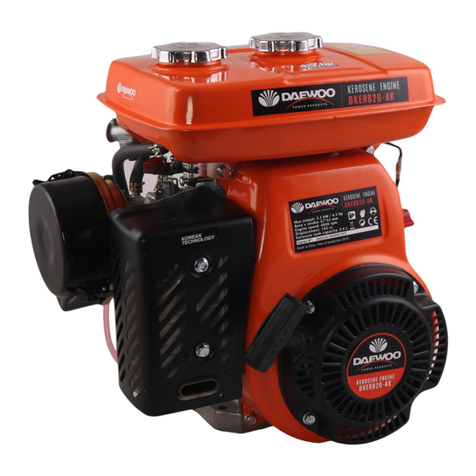
Daewoo
Daewoo DKERB20-AK User manual

Daewoo
Daewoo CIELO EURO III User manual

Daewoo
Daewoo GAE Series User manual
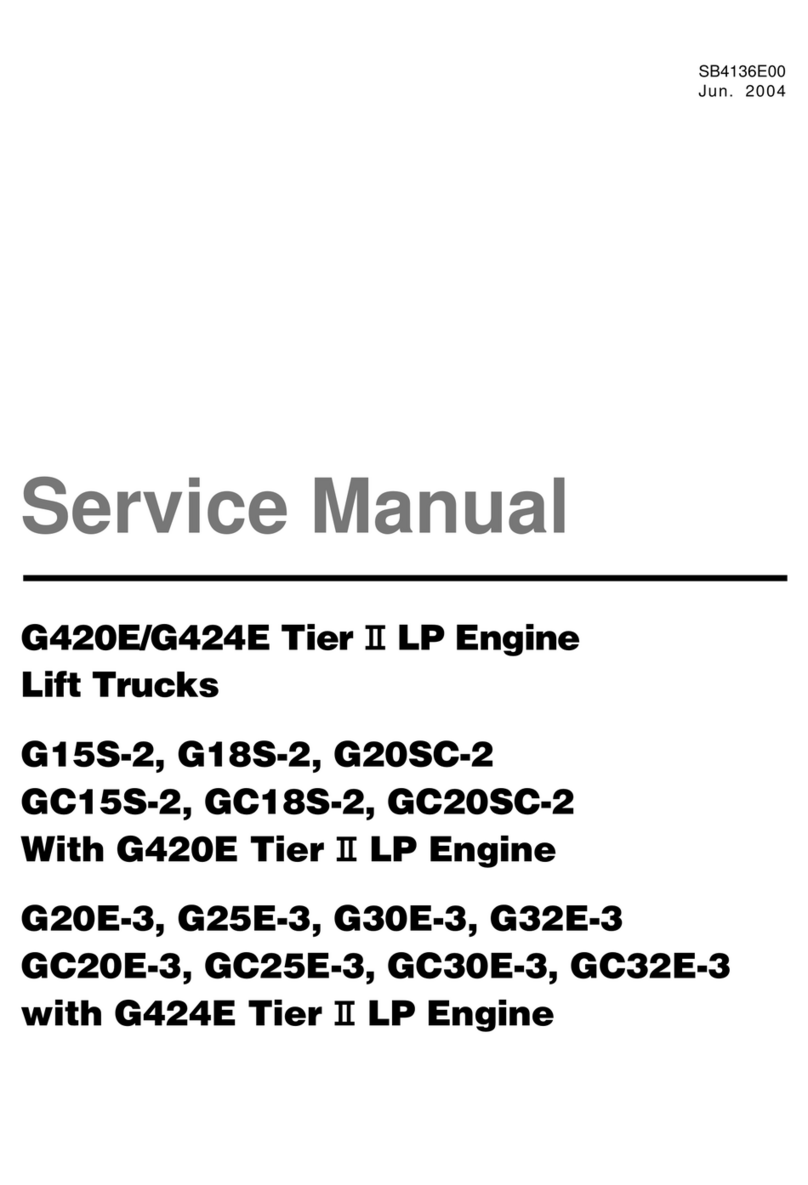
Daewoo
Daewoo G420E User manual
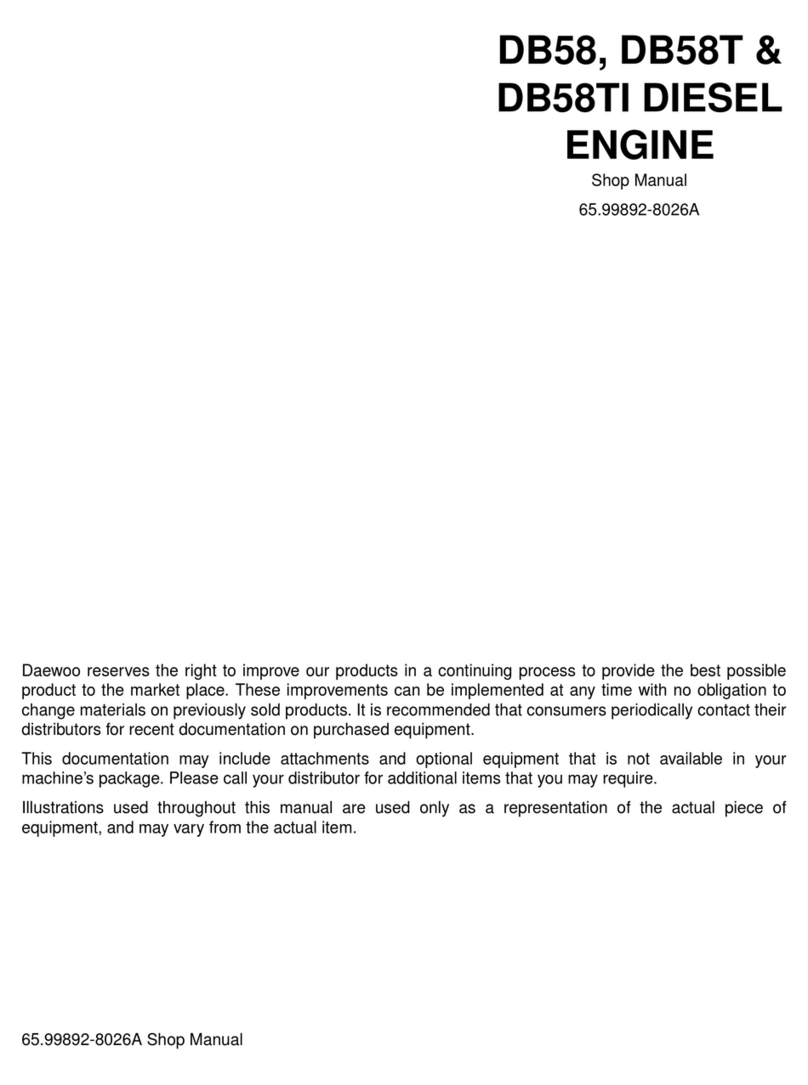
Daewoo
Daewoo DB58 Install guide

Daewoo
Daewoo D1146 User manual
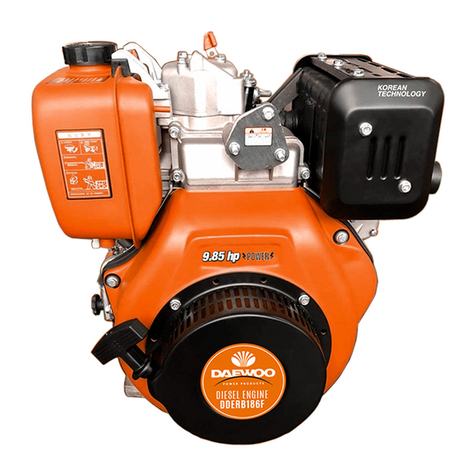
Daewoo
Daewoo DDERBF Series User manual

Daewoo
Daewoo DE12 Install guide

Daewoo
Daewoo DE12T User manual

Daewoo
Daewoo G424 Gasoline User manual
